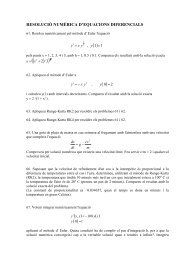Universitat de - Departament d'Astronomia i Meteorologia ...
Universitat de - Departament d'Astronomia i Meteorologia ...
Universitat de - Departament d'Astronomia i Meteorologia ...
You also want an ePaper? Increase the reach of your titles
YUMPU automatically turns print PDFs into web optimized ePapers that Google loves.
1.2. Microquasars 23<br />
Low-hard state High-soft state<br />
L-H state Off state<br />
Figure 1.8: Two-year monitoring of the black hole candidate GX 339−4 at radio wave-<br />
lengths (ATCA and MOST), hard X-rays (BATSE, 20–100 keV) and soft X-rays (RXTE<br />
ASM, 1.5–12 keV) (from Corbel et al. 2000).<br />
transitions between spectral states take place. Then, the radio emission is optically<br />
thin, probably as a result of major ejections of relativistic plasma clouds.<br />
After these observational results, it was proposed that compact radio jets may<br />
always be present during the low/hard states (as observed in other sources), while<br />
are suppressed in the high/soft states. The reason is not clear yet, but a coupling<br />
between the radio jet and the hard X-ray emitting corona is firmly established. A<br />
suggested possibility is that the corona is in fact the base of the radio jet.<br />
On the other hand, the synchrotron radiation mechanism, which is at work in<br />
the jet, has been seen up to infrared and possibly optical wavelengths. Moreover,<br />
it has been suggested that it could also generate photons up to X-ray energies in<br />
its optically thin part. If this is correct, then the jets would be extremely powerful,<br />
and certainly any mo<strong>de</strong>l explaining accretion should account for their presence.






